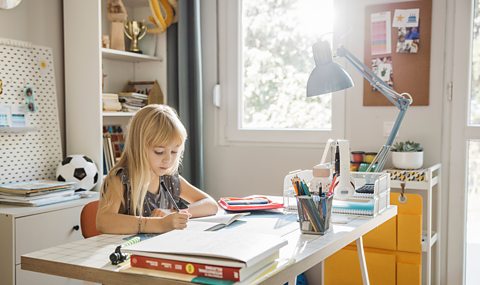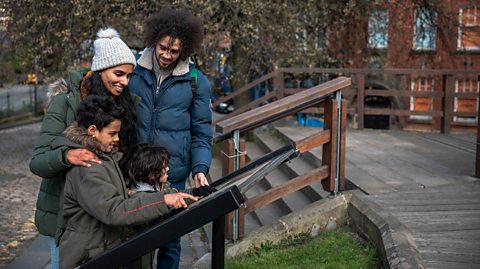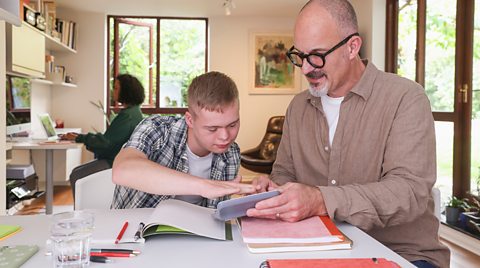Sign up to the BBC Bitesize newsletter! External LinkSign up to the BBC Bitesize newsletter!
For home education news and stories plus updates on the latest Bitesize content, register for our newsletter today.

If you’re thinking of home educating your child, make sure you read the guidelines on how to home educate in the UK. You’ll need to be confident you can provide a full-time education for your child from the age of five.
As well as the formal things like deregistering your child if they’re already attending school, you may also wish to plan things like when and where you’ll educate your child, what they’ll learn and how you’ll monitor their progress.
Five simple steps to home education
To help you along the way, BBC Bitesize has put together five simple steps to home educate in the UK.
1. Get your space set up for home learning
Every parent’s approach to home education will be different. Some parents find child-led learning works best for them. If that’s you, you may wish to observe your child first and note when they’re most engaged, and where. Then you can create an environment at home and outside the home that promotes learning for them.
If you want to create a dedicated learning space, think about how your child focuses best, including their sensory preferences. Your child doesn’t need to be sitting down to learn, so factor that into your thought process.
If your child is learning organically, or through play, will you set up the space initially with some toys and prompts, will you leave labelled boxes out containing different toys and activities, will you have a rug or carpet space available, will you have a ‘tidy-up time’, and will you signal an end to the ‘school’ day or not - even if the latter is more for yourself than your child?

If you’re going for a desk-and-chair set-up, you could use a foldaway desk or fold-up table, section off a part of the kitchen table or part of the living room or, if you have space, a designated room that you can close the door on at the end of the day.
Ask yourself:
- What does your child need to feel comfortable and focused? Think about lighting, colour, furnishings and minimal distractions.
- Where will you store books and other resources?
- Will you have visual timetables, learning prompts or motivational posters on the walls? Will they be there permanently or is there a way you can cover them during downtime?
There are lots of ideas online on how to set up an inspirational learning zone for your child.
2. Decide on your timings: what to learn and when
When deciding whether to structure your day or not, you’ll need to figure out what suits your child’s and your family’s needs best.
Parent Lucinda Wood has been home educating her youngest child since he was seven. They initially tried a more formal set-up with workbooks and a timetable, which “failed dramatically” within three days.
Lucinda explains: “I turned to investigating online and discovered Educational Freedom (which offers home education information and support), and which I now co-own. The original co-founder kindly went through the different styles of home education and how to see which one suited my child… Almost eight years later we’ve never looked back, and my child thrives.”
She and her son chose a style of learning, “somewhere between semi-formal and child-led… As we have no set routine we can be studying astronomy at 11.30pm out on the local village green, watching star constellations, the aurora borealis or shooting stars and comparing it to star charts we’ve made earlier in the week, safe in the knowledge we don’t have to be up at 7am the following morning if needed."
She continues, "The weekend tends to be more down time, but like many home ed kids, the learning never stops. He has watched YouTube documentaries at 7am on his device while still in bed, museum trips are adored… and there’s always a family ready to go off and explore."

Adding rhythm to your day
On the flipside, Emma, who home educates her three children in the New Forest, prefers having a rhythm to their day: “For example, we have activities, outings and outdoor time in the mornings, followed by lunch and home ed and my work time in the afternoons.”
When finding a rhythm that works for both you and your child, consider:
- What do you want to get out of home education for your child?
- When does your child focus best, eg: morning or afternoon?
- How long can they focus before they need a break or change in activity?
- How much do you ideally want to get through in a day?
- What other things do you need to do, eg: paid work, household chores, etc?
Some parents prefer a weekly rhythm. This could mean home-based activities on Mondays and Tuesdays, sports and outdoor activities on Wednesdays, home schooling group on Thursdays and museum or gallery trips on Fridays.
If you decide to use anything like a timetable, daily or weekly planner, display it clearly for your child using colour, images, highlighters, etc, to make it engaging and easy to understand.
3. Think how you’ll home educate: by topic, interest or intuition
Lucinda says: “The best thing you can do for your child is to research… See what style of learning best suits your individual child.”
Many parents don’t teach by ‘topic’ but rather learn as they experience things. For example, Emma from Gloucestershire, who home educated her two children, says: “We went with what they were interested in and didn’t separate it out into subjects. If we went on a trip somewhere to a castle, local historical attraction or science museum, that covered all sorts of different subjects."
Emma explains: "We’d write about it, talk about the journey there, calculate how to get there, and there’d be the interaction with others, as we'd often go as a group. We’d use the content of where we’d visited to talk about later and have discussions… It’s really holistic, rather than saying ‘Oh, we’re doing history today because we’re going to that museum’.”

Lucinda says: “We follow topical studies which cover many subjects such as geography, history, English, politics, etc, in one…"
"Two years ago my son wanted to learn about Poirot," says Lucinda. "We listened to audiobooks and read paperbacks written by Agatha Christie and discussed the language and technique in them. He then took a free course on the Golden Age of Crime… He created a timeline of Christie's life and major events which were occurring in the world at the time… We could then visit the National Trust house she lived in and set some of her novels from, and even visited some of the places where events in her novels took place.”
You could also choose a ‘theme’ for the day, such as seaside animals, British famous people or food chains - whatever takes your and your child’s fancy!
See also our ideas for seaside family adventures, free activities to do outside the house and our guide to strewing.
4. Consider what your role is and who you can ask for help
Think about how you see yourself: are you your child’s teacher, their guide, facilitator, fellow learner, or all of those things?
Then think about your own strengths and areas you’d prefer to outsource or share with others. Many home educating parents try a mixed approach to learning, including:
- hybrid or flexi-schooling
- outsourcing some areas to tutors
- sharing learning or ‘lessons’ with other parents and home education groups
- forest schools and outdoors-based learning
- group trips out
Experiment with what works for you or use a combination. The benefits of sharing the load include you and your child having social contact and space away from one another if needed. It can also spread the financial burden.
Lucinda says, in addition to topic-based learning, “every Monday [my son] has an hour or so with his English tutor. This is for his dyslexia and learning ways to overcome this. Spellings can take place in car parks or on bus trips.”
They listen to podcasts on topics he’s interested in while commuting and share lifts for his older sibling to and from college, which gives Lucinda’s son exposure to other children and learning.
For reassurance about your home education approach, read about ten common fears and tips for overcoming them.

5. Look at how you’ll monitor progress and if you’re doing it ‘right’
You’ll need to decide if and how you want to measure how your child is doing. You can look at BBC Bitesize resources by age if you want an idea of how your child’s knowledge compares to the UK school curriculums.
Remember, the ideal end goal is a child who’s confident in their ability, able to reach their potential and lead a fulfilling, independent adult life.
Younger children
There are lots of ideas on how to monitor progress in our downloadable activities for ages 5-11, including a topic checklist, progress tracker and reward chart.
Consider setting some simple weekly or daily goals, such as reading something together, discussing a topic they’re interested in or encouraging them to research something independently.
Make sure you celebrate the wins, whether that’s a task they’ve completed or a milestone they’ve reached, such as reading their first chapter book.
Older children
Our downloadable activities for ages 11-16 includes SMART goals:
- Specific: keep your goals clear
- Measurable: track your progress
- Achievable: make sure you can accomplish your goal
- Relevant: align your goals to what you are learning
- Time-bound: set a strict deadline
SMART goals may be particularly helpful when your child is learning independently.
Lucinda, whose son is now 14, says: “To ensure he’s understood a topic thoroughly before moving on I use TES and other places’ end of module tests, CGP educational books, Open University tests, etc, to ensure the subject is thoroughly understood and covered before the next deep dive.”
Bitesize has a wide range of quizzes which are designed for students taking GCSEs but can be used for general knowledge too.
Where can I find more support for home education and parenting?
The BBC Bitesize home education collection is designed to support you and your child’s learning at home with free resources for early years and foundation stage (EYFS), primary and secondary-age students.
Bitesize Parents’ Toolkit is the go-to place for the whole parenting community to find stories, expert advice and fun activities.
If your child has special educational needs and / or disabilities, be sure to check out the Parents’ Toolkit SEND collection. Bitesize also has a collection of Sensory Stories, an immersive video series that transports you on unique sensory adventures, for children with additional or complex needs.
For more information about home education, these BBC News articles cover the rise in families deciding to educate their children at home and, from 2021, the impact of Covid on home education.